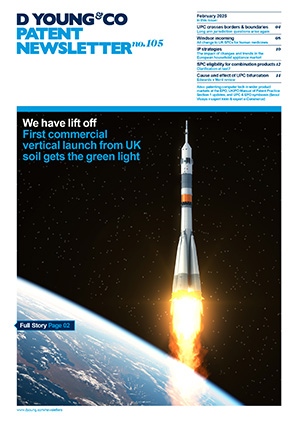T 1473/19: claim interpretation in view of the description
In T 1473/19, the European Patent Office (EPO) Board of Appeal revoked a patent for added matter, because the normal interpretation of the claim lacked basis following a missing comma discrepancy between the claims and the description.
At first glance, this case appears to be a reminder of how easy it can be to fall foul of the added matter trap at the EPO. However, there are other interesting aspects to this decision, particularly questioning whether Art.84 EPC relates to claim interpretation, where Art. 84 of the European Patent Convention (EPC) is often used as basis to justify a request for amendments to the description to be in-line with allowed claims.
Background
EP2621341B1 relates to a contactless rotary joint, where claim 1 recites: “…a rotary joint body (200) of a plastic material, said body having a free inner bore holding a capacitive data link…”
The opponent asserted that claim 1 contains added matter because it requires that the free inner bore holds the capacitive data link (interpretation a), whilst the application as filed only discloses a joint wherein the rotary joint body, not the bore, holds the capacitive data link.
The opposition division rejected the opponent’s argument and agreed with the patentee that claim 1 should be interpreted in the context of the specification, and thus found no added matter.
Appeal
The opponent appealed the decision of the opposition division, asserting that claim 1 is clear and there is no reason to consult the description to interpret the claims, so the lack of a disclosure in accordance with claim 1 means that the claims comprise added matter.
The patentee asserted that the claims did not comprise added matter because they should be interpreted in the context of the description. The patentee submitted auxiliary requests for correction under R.139 EPC, adding commas defining the “free inner bore” as a sub-clause: “said body, having a free inner bore, holding a capacitive data link” (interpretation b).
The Board of Appeal thus had to interpret the claims to decide if the claims contained added matter and if the proposed corrections would broaden their scope.
Interpretation
Articles 69 and 84 EPC refer to the scope of protection of claims:
- Article 69(1) EPC states: “The extent of the protection conferred by a European patent or a European patent application shall be determined by the claims. Nevertheless, the description and drawings shall be used to interpret the claims.”
- Article 84 EPC states: “The claims shall define the matter for which protection is sought. They shall be clear and concise and be supported by the description.”
The Board of Appeal noted in its decision at 3.3 that, according to established case law, claims must be interpreted through the eyes of the person skilled in the art, who should “try, with synthetical propensity, i.e. building up rather than tearing down, to arrive at an interpretation of the claim which is technically sensible and takes into account the whole disclosure of the patent.” (Case Law of the Boards of Appeal, 10th edition 2022, II.A.6.1, first paragraph).
However, the Board of Appeal noted that there is divergent case law over the extent to which the description and drawings should be used to interpret claims. In many decisions, the description and drawings were used to interpret claims and identify their subject-matter (case law of the Boards of Appeal, 10th edition 2022, II.A.6.3.1, second paragraph), whilst in others, the description and drawings were only used to interpret claim features that were ambiguous, whilst unambiguous terms were interpreted without taking the description and the drawings into account (T 197/10, T 1127/16).
Interestingly, the Board of Appeal noted in it’s decision at 3.8 that in it’s view: “Article 69 EPC and the Protocol are the only provisions in the EPC containing rules for the interpretation of patent claims. Article 84, first sentence, EPC does not contain any such rules”. Rather, the rationale underlying both the specific requirements under Article 84, second sentence, EPC (as to clarity see, for example, T 6/01, Reasons 14), and the general requirement under Article 84, first sentence, EPC (see T 3097/19, Reasons 28 and 28.1), is to enable a clear delimitation of the extent of protection. In other words, claims must satisfy the requirements under Article 84 EPC so that they can fulfil their purpose of enabling the protection conferred by the patent to be determined under Article 69 EPC (see G 2/88, Reasons 2.5). Article 84 EPC, however, says nothing about how to interpret patent claims. At most, it defines the standard to be applied when assessing clarity.
The Board of Appeal further noted in its decision at 3.13 that a patent claim must, like any text, be interpreted in its context, which includes the description, agreeing with T 556/02 and T 1646/12 and adding that: “the description and the drawings provide context-specific information about the claimed subject-matter. Taking this information into account when interpreting a patent claim from the perspective of the person skilled in the art makes claim interpretation more accurate, which contributes to legal certainty; all the more so if, as is often the case, patentees use terms idiosyncratically in the claims.”
However, in assessing the extent to which the description should be considered when interpreting the claims, the Board of Appeal emphasised at 3.16 that the claims carry more weight and that this is compatible with Art.84 EPC: “one must not deduce from the applicability of Article 69 EPC in conjunction with Article 1 of the Protocol that the description has the same weight as the claims”. According to Article 69(1), first sentence, EPC only the claims determine the extent of protection. The Board of Appeal noted that there is no contradiction on this issue between Article 69(1), first sentence, EPC and Article 84, first sentence, EPC.
The Board of Appeal also confirmed at 3.16.2 the established principle set out in Case Law of the Boards of Appeal, 10th edition 2022,II-A 6.3.1, third paragraph, that “A discrepancy between the claims and the description is not a valid reason to ignore the clear linguistic structure of a claim and to interpret it differently (T 431/03) or to give a different meaning to a claim feature which in itself imparts a clear credible technical teaching to the skilled reader (T 1018/02, T 1395/07, T 1456/14, T 2769/17)”.
Conclusion
The Board of Appeal concluded that the skilled person would interpret claim 1 as granted, in the absence of any commas, as meaning that the free inner bore holds the capacitive data link (interpretation a).
The Board of Appeal indicated that this interpretation was “technically sensible and plausible” and that, contrary to the patentee’s argument, the person skilled in the art would have no reason to depart from it for technical reasons, noting at 4.4 that:
- The fact that the contested claim feature as understood in accordance with interpretation a) is not disclosed in the description or drawings does not speak against this interpretation.
- Neither the description nor the drawings exclude the presence of a (further) capacitive data link positioned in accordance with interpretation a).
- There is no principle of claim interpretation according to which a claim should be interpreted in a manner which makes it compliant with Article 123(2) EPC.
- Contrary to the description and the drawings, the application as filed is not referred to in Article 69(1), second sentence, EPC either.
- The description and the drawings do not contain anything which makes interpretation a) appear technically nonsensical or incompatible with the claimed invention. The description does not contain a definition of the contested feature either.
- Mention, for example, of an embodiment which comprises a capacitive data link not arranged in accordance with interpretation a) is not a sufficient reason to apply interpretation b) instead of interpretation a).
The Board of Appeal thus found no reason to depart from the normal meaning of the description and so found the granted claims to comprise added matter.
The Board of Appeal also rejected the patentee’s auxiliary requests for correction. Applying the same interpretation, the Board of Appeal found that the proposed corrections would unallowably extend the scope of protection, and found that the proposed corrections would not have been obvious to make, because the claim made technical sense. As a result, the Board of Appeal revoked the patent.
Further comments
First, it is interesting that the Board of Appeal rejected the argument that Art.84 EPC relates to claim interpretation, which is often used to justify a request for amendments to the description to be in-line with the allowed claims under GL: H-V 2.7. As such, this decision challenges other decisions that suggest that these amendments are justified by Art.84 EPC.
However, in this case, if the EPO had made such a request during prosecution, then this might have highlighted the inconsistency earlier, and so potentially avoided revocation of the patent.
Second, the Board of Appeal’s reference at 4.4 to Art.69 EPC, not referring to the description and drawings as filed, is also of note.
This appears to underline that an amended description could lead to a different interpretation of the claims, and hence reinforces the need for caution when amending the description to avoid inadvertently adding matter.
Useful links
- Patent EP2621341B1, European patent office, 26 April 2017: dycip.com/eprotaryjoint
- Case Law of the Boards of Appeal, 10th edition 2022, II.A.6.1: dycip.com/boacaselaw6-1
- Case Law of the Boards of Appeal, 10th edition 2022, II-A 6.3.1: dycip.com/boacaselaw6-3-1
- GL: H-V 2.7, European patent office: dycip.com/epoguidelines2-7
Case details at a glance
Jurisdiction: European Patent Office
Decision level: Board of Appeal
Applicant: Schleifring GmbH
Citation: T 1473/19
Date: 30 September 2022

